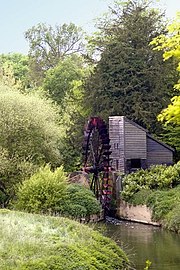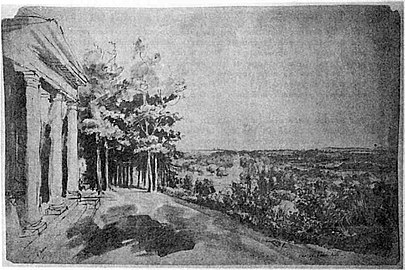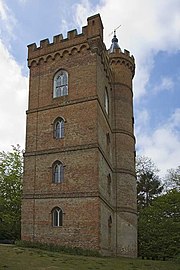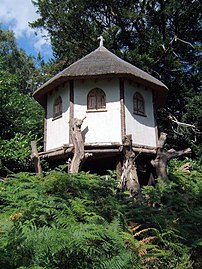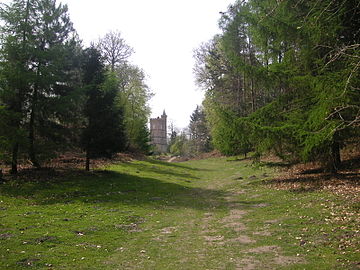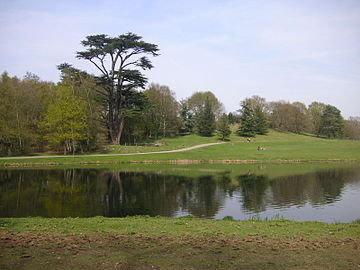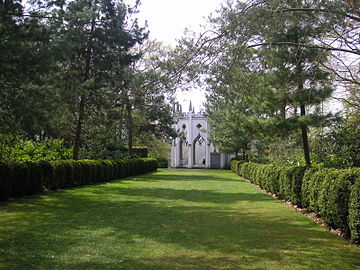Painshill
| Painshill | |
|---|---|
Elmbridge Borough Council | |
| Open | Every day (except Christmas and Boxing Day) |
| Collections | John Bartram Heritage Collection |
| Designation | Grade I |
| Connecting transport | South Western Railway |
| Website | http://www.painshill.co.uk |
Painshill (also referred to as "Pains Hill" in some 19th-century texts
Painshill is owned by
History
Charles Hamilton was born in 1704 in Dublin, the 9th son and 14th child of James Hamilton, 6th Earl of Abercorn. He was educated at Westminster School and Oxford, and went on two Grand Tours, one in 1725 and a further one in 1732.
In 1738 Hamilton began to acquire land at Painshill and, over the years, built up a holding of more than 200 acres (81 ha). His creation was among the earliest to reflect the changing fashion in garden design prompted by the Landscape Movement, which started in England in about 1730. Hamilton used what today are called
Hamilton eventually ran out of money and sold the estate in 1773 to Benjamin Bond Hopkins,[9] who held the estate until his death in 1794.[10] In 1778 Hopkins commissioned architect Richard Jupp to rebuild Painshill House in a different place within the park. The house was later extended in the 19th century by architect Decimus Burton and is now a grade II* listed building.[11]
Sir William Cooper and his wife, later his widow, lived there until 1863, and installed Joseph Bramah's suspension bridge and water wheel, and planted an arboretum designed by John Claudius Loudon. In 1873, the English poet, literary and social critic, Matthew Arnold, rented Pains Hill Cottage from Mr. Charles J. Leaf and lived there until his death in 1888.[12] In 1904 Charles Combe of Cobham Park purchased and lived in Painshill Park, his son having moved into Cobham Park.
Until World War II Painshill Park was held by a succession of private owners. In 1948 the estate was split up and sold in separate lots for commercial uses. The Park's features fell into decay.
By 1980 the local authority, Elmbridge Borough Council, had bought 158 acres (64 ha) of Hamilton's original estate and the work of restoring the landscape garden and its many features could start. In the following year, the Painshill Park Trust was founded as a registered charity with the remit "to restore Painshill as nearly as possible to Charles Hamilton's Original Concept of a Landscaped Garden for the benefit of the public."[13] There is a wealth of 18th-century images of the main features of Painshill to help the process.
The restoration of this Grade I continued, in 2013 work was completed on the restoration of the Crystal Grotto, further restoration work in the park is dependent on the availability of funding. The park now borders the A3 road, which allows easy access.
Description
Today Painshill comprises 158 acres (64 ha) of the original more than 200 acres (81 ha) owned by Charles Hamilton in the 18th century. The landscape garden stretches along the banks of the winding River Mole on land that has a number of natural hills and valleys.
The central feature is a serpentine lake of 14 acres (5.7 ha)
All these still exist and have been restored, and the
Among the original plantings are a number of important specimens including fine examples of
In popular culture
The landscape garden has been a location for film and television production, such as for the grounds of "Bridgeford University" in the 2009 ITV2 series Trinity and the exteriors in the movie adaptation of Oscar Wilde's The Picture of Dorian Gray (2009 film). In 2017, Painshill Park was featured in the science fiction television series Black Mirror, episode "Hang the DJ".[20]
Gallery of features and follies
-
A cast of Giambologna's Rape of the Sabines
-
The Gothic Temple
-
The rebuilt Turkish Tent
-
The Chinese Bridge
-
The Crystal Grotto
-
The waterwheel
-
The cascade
-
View from the Temple of Bacchus, Gothic Temple in middle distance. Elias Martin, c. 1770
-
View of the re-created Temple of Bacchus, 2018
-
The Gothic Tower
-
The vineyard in winter
-
The reconstructed hermitage
-
The Alpine Valley contrasts with other areas of the park, and leads up to the Gothic Tower.
-
The Great Cedar is thought to be the largest in Europe.
-
The "amphitheatre": an ancient Cork Oak and two Cedars form the setting for a shrubbery and a cast of a Renaissance statue after Giambologna
-
The Gothic Temple is at the end of an avenue of pines and hedges.
See also
- Hagaparken – Copper Tents, Turkish Kiosk, Chinese Pavilion, Haga Echo Temple
- Robert Hibbert
References
- ^ Google Books search for "Pains Hill, Surrey."
- ^ Historic England, "Painshill Park (1000125)", National Heritage List for England, retrieved 5 February 2016
- ^ a b Painshill Park Trust brochure, Welcome to Painshill
- ISBN 978-1-5272-4309-5.
- ^ John Bartram Heritage Collection Archived 2010-07-15 at the Wayback Machine
- ^ "The restoration of Painshill's English landscape garden". Financial Times. 26 September 2014. Retrieved 19 February 2023.
- ^ Jefferson tour
- ^ "Museum number 1898,0906.1". British Museum. Retrieved 25 November 2020.
- ^ "Painshill Park: The restoration of a classical 18th-century landscape - Parks and Gardens UK". Archived from the original on 23 December 2012. Retrieved 30 June 2012.
- ^ http://www.elmbridgemuseum.org.uk/elmbridgehundred/biographies/biography.asp?id=349[permanent dead link]
- ^ Historic England. "PAINSHILL HOUSE (1030132)". National Heritage List for England. Retrieved 7 November 2014.
- ^ Arnold, Matthew (1895). Letters of Matthew Arnold 1848-1888. Macmillan. p. 119.
- ^ (no byline) (24 May 2017). "Painshill Park in Cobham is a hidden Surrey gem that could be threatened by traffic – Rural Ramblings". Surrey Life. Retrieved 31 May 2021.
- ^ Gardens Guide, Painshill Park, Surrey
- ^ "Lady Lucinda Lambton places the last crystal in the Grotto". Painshill. Archived from the original on 14 August 2014. Retrieved 31 May 2014.
- JSTOR 1586476.
- ISBN 978-3-932759-00-0.
- ^ Old Trees in Netherlands and Western Europe Archived 2008-02-13 at archive.today
- ISSN 0262-558X
- ^ Gamp, Joe (30 December 2017). "Where was Black Mirror Hang the DJ filmed?". Metro. London. Retrieved 29 January 2018.
External links
Painshill Park.






